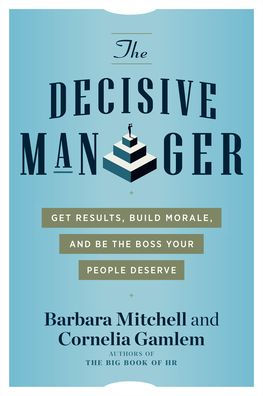
Employees today expect career growth and development. At the same time, employers are identifying new skills needed in a changing workplace.
“Rather than hire new talent to fill gaps, consider upskilling or reskilling your current staff. Give people the opportunity to do something different for your organization,” says Cornelia Gamlem, coauthor of The Decisive Manager.
In times when the labor market is tight, managers and their organizations may be anxious to satisfy all of these needs. However, so many questions may stall their desire to do so. What are the best training methods and experiences? How can I be sure that the events employees attend are relevant to their jobs? Will they apply what they learn?
Individual employee development
Managers can start by looking at the changing needs of their department and any new skills necessary to meet those needs. This can be followed by individual employee development. Assess your team’s abilities and consider creating individual development plans, which typically include the following:
- A clear statement of professional goals and objectives
- Steps and activities to achieve them
- Work opportunities or assignments of interest for the short and long term
- An assessment of the necessary qualifications to perform those assignments
- An evaluation of training and development needed to prepare for those assignments
In the short term, especially if you are initially concerned with changing needs, focus on number three—work opportunities and assignments. Developmental activities can include, but aren’t limited to, the following:
- Education—certificate programs, conferences, seminars, and webinars
- Self-study—reading, podcasts, blogs
- Participation in professional organizations
- Virtual learning
- Participation in projects and on teams, task forces, or committees
- Stretch assignments
Employee development
Employee development is a partnership between an employee and their manager. When your employees first sign up for a learning event, go over the objectives with them to ensure it will best meet their and the organization’s needs. Consider:
- If it will help the employee in their current job or prepare them for future opportunities.
- If they will be learning about new developments in their field that a credible source is delivering the program.
Afterward, review with the employee what they learned. This type of follow-up sends a powerful message and aligns the thinking between you and the employee. Things to check and follow-up actions to take include:
- Reviewing any course material with the employee.
- Asking questions: What did they learn? Are there things they don’t understand?
- Inquiring if other team members would benefit from the same workshop or course.
- Giving them assignments where they can apply and practice what they learned.
- They monitor their job performance and let them know whether they are effectively applying what they learned to their assignments. If they are not, it’s an excellent opportunity for coaching.
If the learning concerns new or emerging developments, have the employee share what was learned with other team members and managers. This accomplishes several things that will motivate employees:
- It positions the employee as the subject matter expert—the go-to person for what’s new. What better way to motivate employees?
- It allows you, the manager, to learn something from your employees.
- It demonstrates your interest and partnership in all your employees’ learning.
Of course, in today’s fast-paced, changing world, training events such as conferences and workshops don’t always meet an organization’s needs. It’s time to get serious about microlearning.
Microlearning is turning content and learning into little bits and pieces. It’s a way of delivering learning. Cell phones and mobile technology now play a significant role in how business is conducted today, and microlearning is an excellent fit for this technology.
Why consider microlearning, and what are its advantages?
- It delivers content just in time. Text messages with links to watch short videos and demos or infographics can be sent to employees, allowing them to view them at their convenience. It’s flexible.
- Texts with reminders about work to complete work upcoming training sessions. Text messaging is the preferred method of communication for many and is more reliable than email. It has a 90 percent plus open rate versus a 20 percent email available rate.
- Microlearning and text messaging can increase employee engagement. If you send employees to your learning management system (LMS), they will likely avoid or ignore it. With mobile technology, you can store content from your LMS on a mobile website. Add buttons, and that mobile platform connects to LMS pag, instantly becoming a repository for content needly or a portal where the content can be discovered. It’s easy to access.
- Mobile learning solutions can help retain content. Texting a link to employees scheduled for testing, makes it easy for them to click a link, take the test and be done in minutes. The data is instantly available to you in a reports function. It’s fast and fun, and employees will participate.
- Beyond tests, you can create polls and surveys and get results within minutes. This is so much less cumbersome than answering emails and completing long surveys.
A commonly held myth is that microlearning is chunking a training program into segments—parts one, two, and three, for example. However, with chunking, employees must watch all three components to get the full advantage. Microlearning encapsulates the learning into one bite-sized piece. It’s short bursts of focused “right-sized” content to help people achieve a specific outcome. It’s important the content is focused on a single, precise learning objective.
Another myth is that microlearning is high-tech, but that is not necessarily the case. Microlearning can be as simple as an infographic or a checklist—those evergreen tools that managers and employees can use.
Can all learning be micro-sized? Some topics, such as processes and procedures, are well suited for microlearning bits. Soft skill training, such as leadership training, is best offered in a classroom or virtual setting. Even that exercise can be augmented into bits that reinforce the classroom learning.
Book Link: https://www.amazon.com/Decisive-Manager-Results-Morale-Deserve/dp/1632652013/



